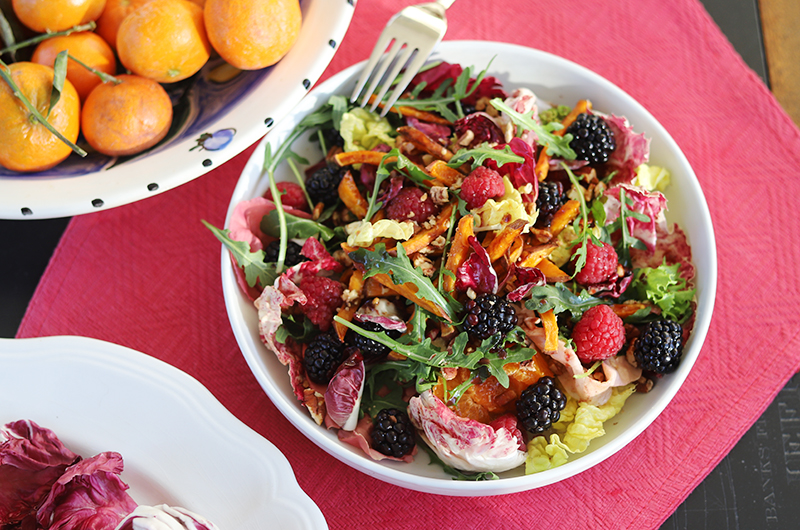Twelve years ago when I arrived on the Vineyard, eating local year-round was mostly a dream. I was so enamored of the whole concept (you know, the whole everything-but-the-chocolate-and-the-coffee thing) that I tried my best one winter to go for it. In my rental there was a deep, dark, scary closet over the garage that stayed cool (kind of like the rest of the rental), and in there I stuffed a big stash of Morning Glory Farm butternut squash that I got at the end-of-season sale. I think I had a bucket of onions and a refrigerator drawer full of parsnips too. (Did you know that, wrapped well, parsnips keep forever – and ever? And ever?)
So you can guess how that turned out. It’s a miracle I still like root vegetables. But truthfully, I get so over stimulated in the summer that I love the idea of simple eating in the winter. Basing my diet around greens, root vegetables, eggs, and shellfish – as well as the leavings of summer, preserved in a jar (tomato sauce, pickles, jams) – is pretty appealing. But these days, I don’t have to be a Euell Gibbons caricature about the whole thing (though if you’ve never foraged for wild cranberries and wild hazelnuts on Chappaquiddick, you should). Today there’s an embarrassment of locally grown and made riches – from bread and cheese to beef, pork, lamb, duck, and chicken; from spinach and kale to carrots and leeks. Local honey. Local salt. Local garlic. Local sausage. Local bacon.
I hope you’ll forgive me if I confess that, despite all this good stuff, I’m still into the whole greens and root vegetables thing. I’m especially fascinated by farmer Rusty Gordon’s success at growing greens year-round in his hoophouses at Ghost Island Farm in West Tisbury. When I was a farmer, I read organic gardening guru Eliot Coleman’s book The Winter Harvest Handbook (Chelsea Green Publishing, 2009) and learned that despite the reduction in sunlight over the winter (when basically nothing grows much), I could still harvest greens from a hoophouse all winter if I started them at the right time in the fall and covered them in layers of fabric row cover and plastic. (Each layer essentially transports the bed into a different plant hardiness zone.)
Much to my excitement, I managed to bring some arugula, spinach, and kale through the winter in my small hoophouse. So watching Gordon do this on a large scale – growing enough to keep his farm stand open all winter (hurrah!) – is very cool. Timing is the tricky thing, he told me recently: you’ve got to germinate the seeds and get them growing before it gets too cold, but you don’t want the plants to be too far along, either.
I also asked him if he’d have baby kale (a personal favorite), and he said that harvesting mature kale is more sustainable. I get that – if you harvested baby kale in the cold months, you’d basically be cutting the plant off at its knees, never to grow again. If you let the kale plant establish itself before winter, you can harvest leaves from one plant for months. The thing is, Gordon’s “mature” kale (I bought a bag while talking to him) is so tender that you’ll have no problem using it raw in salads as you would baby kale. Just remove the stems, tear or chop it into bite-sized pieces, and massage a little vinaigrette into the leaves.
While Gordon keeps the lights on all winter, the Farm Hub at Thimble Farm in Vineyard Haven is doing their off-season community-supported agriculture (CSA) program again this year. There are two types of shares – the Herbivore and the Ovotarian. Both will include greens and seasonal veggies (such as carrots, beets, leeks, and sweet potatoes), but one of those shares (you guess) includes fresh eggs too. Pickups are biweekly and begin either November 4 or November 11 and run through March. Visit the Island Grown Initiative website (igimv.org) for more information.
The Grey Barn and Farm farm stand in Chilmark is open all year (many people don’t realize this), and in addition to their cheese and meat, they are now growing a lot of vegetables, including greens and squashes. Add a loaf of their artisan bread to the mix and you’ve got it made.
You can also plan ahead for post-December eating by taking advantage of the end-of-season specials at Morning Glory in Edgartown. Buy plum tomatoes in bulk and make and freeze a simple sauce. Or buy Morning Glory’s own canned tomato sauce, canned tomatoes, pickles, and jams. And I wasn’t kidding about those parsnips. If you have an extra refrigerator, you can layer parsnips, carrots, and purple-topped turnips in towels in the crisper drawers and they will keep for months.
So while your local diet can be a lot more diverse than hearty salads (with root veg!), I did want to share this recipe with you: Kale Salad with Sweet Potato Fries and Blackberry-Lime Dressing. It’s got a lot going for it, including the antioxidants and nutrients in the kale, the sweet potatoes, and the berries (eat your colors!). It can be turned into a vegetarian main dish by adding a small amount of quinoa to it. Or serve it with sliced roasted local pork. The sweet potato “fries” could be varied to include a mix of potato, sweet potato, and (yes!) parsnip fries. Use tender mature kale, baby kale, or use a mix of hearty greens. Use raspberries instead of blackberries if you like. (I’m afraid you’d have to use cranberries if you’re going for the all local thing.) Anyway, you get the idea.
While you may not be digging a root cellar or tapping your maple trees, I hope you’ll be inspired to include at least some local ingredients in your off-season cooking.








